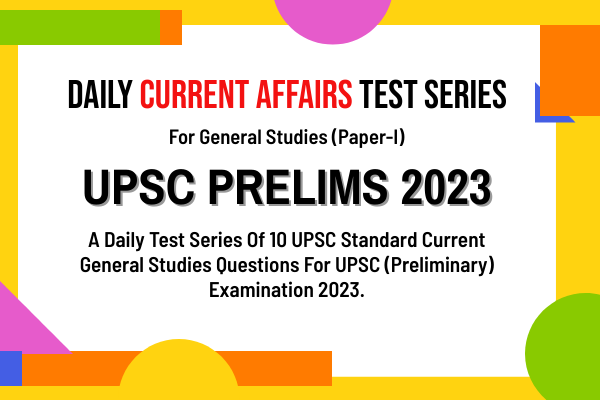Daily UPSC Prelims Current Affairs – August 13, 2022 [Mock Test]
August 15, 2022 August 15, 2022

1. With respect to the Universal Civil Code (UCC) in India, consider the following statements:
- Goa is the only state to have a UCC.
- Ranjana Desai Committee was formed by Central government for implementing UCC.
- Article 43 lays down that the state shall aspire to secure a Uniform Civil Code for the citizens throughout the territory of India.
Which of the statements given above is/are correct?
[A] Only 2
[B] Only 1
[C] Only 1 & 2
[D] Only 1 & 3
Show Answer
Correct Answer: B [Only 1]
Notes:- The Uttarakhand government has formed an expert committee headed by a retired Supreme Court judge, Ranjana Desai for implementing Uniform Civil Code (UCC) and to check all the relevant laws that control personal matters for those living in Uttarakhand.
- Goa is the only state in India which has a uniform civil code. The Goa Family Law, is the set of civil laws, originally the Portuguese Civil Code, continued to be implemented after its annexation in 1961.
- Uniform Civil Code comes under Article 44 of the Indian Constitution,which lays down that the state shall aspire to secure a Uniform Civil Code for the citizens throughout the territory of India.
- Article 37 states that “The provisions contained in this Part (Part IV) shall not be enforceable by any court, but the principles therein laid down are nevertheless fundamental in the governance of the country, and it shall be the duty of the State to apply these principles in making laws”.
2. Consider the following statements:
- India gate and Amar Jawan Jyoti commemorates India’s victory over Pakistan in 1971 war.
- National War memorial was built to commemorate all the soldiers who have laid down their lives in battles, wars, operations and conflict of Independent India.
- National War memorial is based on four concentric circles.
Which of the statements given above is/are correct?
[A] Only 3
[B] Only 1 & 3
[C] Only 2 & 3
[D] 1, 2 & 3
Show Answer
Correct Answer: C [Only 2 & 3]
Notes:- Amar Jawan Jyoti, established in 1972, was to mark India’s victory over Pakistan in the 1971 War, which resulted in the creation of Bangladesh.
- The India Gate, All India War Memorial, as it was known earlier, was built by the British in 1931. It was erected as a memorial to around 90,000 Indian soldiers of the British Indian Army, who had died in several wars and campaigns till then.
- As it was a memorial for the Indian soldiers killed in wars, the Amar Jawan Jyoti was established underneath it by the government in 1972.
- The National War Memorial was inaugurated in February 2019. It was built to commemorate all the soldiers who have laid down their lives in the various battles, wars, operations and conflicts of Independent India.
- The architecture of the memorial is based on four concentric circles. Largest is the Raksha Chakra or the Circle of Protection which is marked by a row of trees, each of which represent soldiers, who protect the country. The Tyag Chakra, the Circle of Sacrifice, has circular concentric walls of honour based on the Chakravyuh. Veerta Chakra, the Circle of Bravery, has a covered gallery with six bronze crafted murals depicting the battles and actions of our Armed Forces. The final is the Amar Chakra, the Circle of Immortality, which has an obelisk, and the Eternal Flame.
3. Which of the following statements on Veer Savarkar are correct?
- He founded Mitra Mela in 1899.
- He established the Free India Society in London along with Madam Bhikaji Cama.
- He authored ‘Hindutva: Who is Hindu?’.
- He supported the Quit India movement.
Choose the correct answer using the codes given below:
[A] Only 1, 2 & 3
[B] Only 2, 3 & 4
[C] Only 1, 2 & 4
[D] 1, 2, 3 & 4
Show Answer
Correct Answer: A [Only 1, 2 & 3]
Notes:- Vinayak Damodar Savarkar and his brother Ganesh Damodar Savarkar founded a secret society called ‘Mitra Mela’ in 1899 which later became ‘Abhinav Bharat Society’ in 1904.
- In London, he established the Free India Society along with Madam Bhikaji Cama.
- He authored a book “The History of the War of Indian Independence” and ‘Hindutva: who is hindu?’.
- During his incarceration in Ratnagiri jail in 1922, he wrote his “Essentials of Hindutva” that formulated his theory of Hindutva.
- In 1937,Savarkar became the president of the Hindu Mahasabha (till 1943).
- He gave the slogan “Hinduize all Politics and Militarize Hindudom”.
- He took an opposing stand during the Quit India Movement.
- He was arrested in 1909 on charges of plotting an armed revolt against the Morley-Minto reform (Indian Councils Act 1909).


